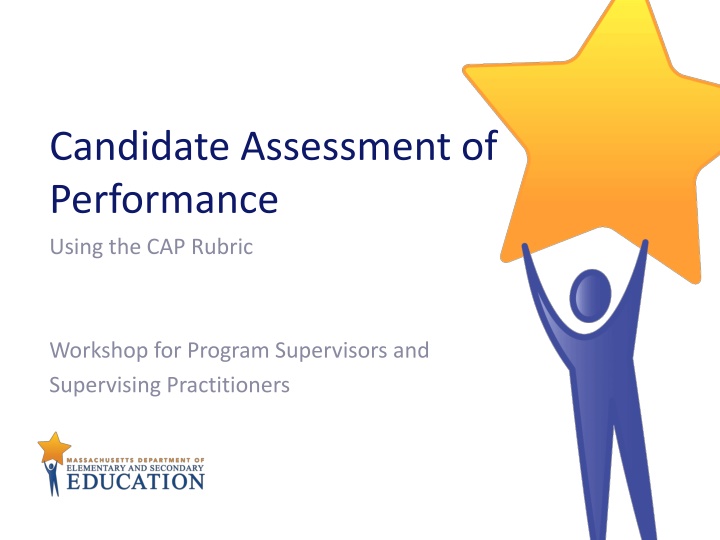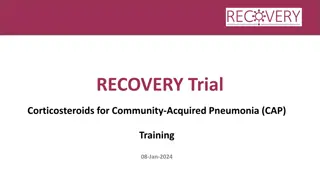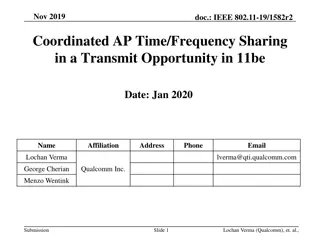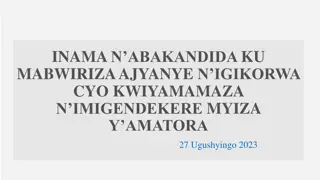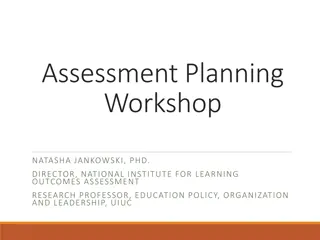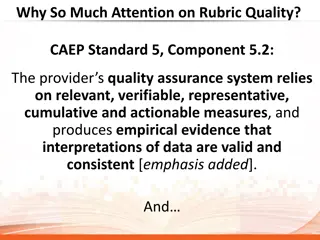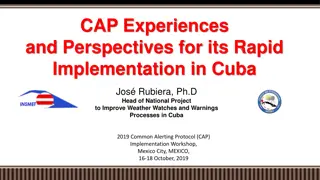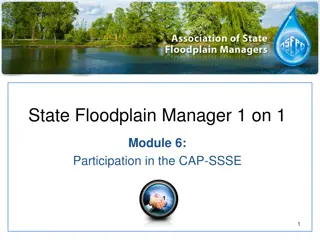Candidate Assessment of Performance Using the CAP Rubric: Workshop Overview
This workshop conducted for program supervisors and supervising practitioners focuses on utilizing the CAP Rubric to assess candidate performance. The agenda includes warming up, learning about the CAP Rubric, understanding its goals and purposes, and detailing the CAP process. Participants engage in activities to support candidates' growth and readiness to impact students effectively. The workshop emphasizes consistent feedback, evaluation, and evidence-based professional judgments to enhance teaching preparedness.
Download Presentation

Please find below an Image/Link to download the presentation.
The content on the website is provided AS IS for your information and personal use only. It may not be sold, licensed, or shared on other websites without obtaining consent from the author.If you encounter any issues during the download, it is possible that the publisher has removed the file from their server.
You are allowed to download the files provided on this website for personal or commercial use, subject to the condition that they are used lawfully. All files are the property of their respective owners.
The content on the website is provided AS IS for your information and personal use only. It may not be sold, licensed, or shared on other websites without obtaining consent from the author.
E N D
Presentation Transcript
Candidate Assessment of Performance Using the CAP Rubric Workshop for Program Supervisors and Supervising Practitioners
Workshop Agenda Warming Up (7 minutes ) Learning (34 minutes) Practicing (34 minutes) Calibrating (25 minutes) Recapping (5 minutes) Total workshop time: 1 hour and 45 minutes 2 Massachusetts Department of Elementary & Secondary Education
Warm Up Turn to a partner: Think about the 5-Step Cycle used in CAP. For each step in the cycle, list the ways that you could use the CAP rubric to support the activities that comprise that step. As a whole group: 4 Share and chart your ideas. Massachusetts Department of Elementary & Secondary Education
Learning Understanding the CAP Rubric
Goals of CAP Provide candidates with opportunities to demonstrate the knowledge and skills they have gained in preparation. Support candidates growth and development through consistent, high quality feedback and evaluation. Ensure candidates are ready to make impact with students on day 1. 6 Massachusetts Department of Elementary & Secondary Education
Purpose of the CAP Rubric Designed to help candidates and assessors: 1. Develop a consistent, shared understanding of what performance looks like at the four performance levels; 2. Develop a common terminology of practice and structure to organize evidence; and 3. Make evidence-based professional judgments about performance ratings. Serves as the content anchor throughout the process. 7 Massachusetts Department of Elementary & Secondary Education
The CAP Process CAP takes place throughout the practicum. Program supervisors, supervising practitioners, and candidates collect evidence of practice, which informs CAP ratings. CAP ratings are determined using the CAP Rubric at three points in the process: When? Who? Why? To reflect on pre-practicum and coursework performance and prepare for goal-setting. Candidate alone Self-Assessment Program Supervisor and Supervising Practitioner together To establish a baseline that will inform goal-setting. To provide feedback on interim progress; no surprises at the summative evaluation. Formative Assessment Program Supervisor and Supervising Practitioner together 8 Summative Assessment Program Supervisor and Supervising Practitioner together To determine whether candidate passes CAP and is ready to teach. Massachusetts Department of Elementary & Secondary Education
Alignment to Educator Evaluation The CAP Rubric uses the performance descriptors from the MA Educator Evaluation Framework model rubric for each of the 6 essential elements in CAP. Essential Element Standard Well-Structured Lessons Standard I: Curriculum Planning, and Assessment Adjustments to Practice Meeting Diverse Needs Safe Learning Environment Standard II: Teaching All Students High Expectations 9 Reflective Practice Standard IV: Professional Culture Massachusetts Department of Elementary & Secondary Education
Alignment to Educator Evaluation BUT goes one step deeper to unpack each descriptor into three dimensions: Quality Scope Consistency These dimensions allow CAP assessors (SPs and PSs you!) to provide more nuanced feedback to candidates and recognize that full proficiency for each element is not the expectation for beginning teachers. 10 Massachusetts Department of Elementary & Secondary Education
Quality, Scope, and Consistency Quality: ability to perform the skill, action or behavior as described in the proficient performance descriptor. The minimum threshold for the quality dimension is performance at the proficient level. Quality is a gatekeeper. Candidates who fail to demonstrate quality at the proficient level should not be rated on scope or consistency and do not pass CAP. For example, if the qualityof a candidate s practice on the meeting diverse needs element is at the needs improvement level at the formative assessment stage, the assessors should not provide ratings on scope or consistency. 11 Massachusetts Department of Elementary & Secondary Education
Quality, Scope, and Consistency Scope: the scale of impact to which the skill, action or behavior is demonstrated with quality. Assessors should consider whether the candidate is able to demonstrate quality with all students, only a subset of students, one student, or no students. The minimum threshold for the scope dimension is performance at the needs improvement level. 12 Massachusetts Department of Elementary & Secondary Education
Quality, Scope, and Consistency Consistency: the frequency that the skill, action or behavior is demonstrated with quality. Assessors should consider whether the candidate is able to demonstrate quality all the time, sometimes, once, or never. The minimum threshold for the consistency dimension is performance at the needs improvement level. 13 Massachusetts Department of Elementary & Secondary Education
CAP Rubric Architecture Provides descriptors of 4 performance levels for each of the 6 essential elements measured by CAP: Exemplary Proficient Needs Improvement Unsatisfactory 14 Massachusetts Department of Elementary & Secondary Education
Rubric Performance Descriptors Provides performance descriptors for each of the 6 essential elements measured by CAP. Example: 15 Massachusetts Department of Elementary & Secondary Education
CAP Rubric Architecture Provides space for assessors to: Document formative and summative ratings. Record a summary of evidence to support each rating. Indicates the minimum thresholds for quality, scope, and consistency. 16 Massachusetts Department of Elementary & Secondary Education
CAP Rubric Architecture Minimum threshold reminders Space to provide formative and summative ratings 17 Record of evidence to support ratings. Massachusetts Department of Elementary & Secondary Education
Using the CAP Rubric Throughout the CAP Cycle Self- Pre-Cycle Assessment Goal Setting and Plan Development Summative Assessment Plan Implementation Click here Formative Assessment 18 Massachusetts Department of Elementary & Secondary Education
Using the CAP Rubric Throughout the CAP Cycle Candidate (C) uses performance descriptors to self-assess performance in pre-practicum, coursework, and Announced Observation #1. Self-Assessment Goal-Setting and Plan Development Program Supervisor (PS) and Supervising Practitioner (SP) use performance descriptors to establish baseline ratings; shared with Candidate at first Three-Way Meeting. Plan Implementation PS and SP use rubric to analyze evidence collected during Announced Observation #1 Formative Assessment 19 Summative Assessment Massachusetts Department of Elementary & Secondary Education
Using the CAP Rubric Throughout the CAP Cycle PS and SP may reference the rubric in the post-conference for Announced Observation #1 (e.g., Based on how the lesson went, tell me about any areas of the rubric that you are currently working to strengthen. ). Self-Assessment Goal-Setting and Plan Development Plan C, PS, and SP consult the rubric when finalizing the professional practice goal to understand how current practice relates to the level of practice necessary to attain the goal the proficient descriptors may be especially helpful here. Implementation Formative Assessment 20 Summative Assessment Massachusetts Department of Elementary & Secondary Education
Using the CAP Rubric Throughout the CAP Cycle PS and SP may reference the rubric in pre- and post-conferences (e.g., Tell me about any areas of the rubric that you are currently working to strengthen. ). Self-Assessment Goal-Setting and Plan Development PS and SP use the rubric to categorize evidence collected during Unannounced Observation #1 and Announced Observation #2. Plan Implementation Evidence should explain what happened in the observation that shows/does not show that a skill has been demonstrated. Formative Assessment Evidence statements should not simply restate the performance descriptors in the rubric. 21 Summative Assessment Massachusetts Department of Elementary & Secondary Education
Using the CAP Rubric Throughout the CAP Cycle PS and SP use rubric performance descriptors to jointly establish formative assessment ratings for each element; shared with C at the second Three-Way Meeting. Self-Assessment Goal-Setting and Plan Development Plan Implementation Formative Assessment 22 Summative Assessment Massachusetts Department of Elementary & Secondary Education
Using the CAP Rubric Throughout the CAP Cycle PS and SP may reference the rubric in the post-conference for Unannounced Observation #2. Self-Assessment Goal-Setting and Plan Development PS and SP use rubric performance descriptors to jointly establish summative assessment ratings for each element to determine whether the C has passed CAP; shared with C at the third Three-Way Meeting. Plan Implementation Formative Assessment 23 Summative Assessment Massachusetts Department of Elementary & Secondary Education
Mapping Evidence At the Formative Assessment step, the PS and SP should review the evidence collected to date and identify any gaps. Action steps should be taken prior to the Summative Assessment to fill gaps (i.e., if evidence is weak for well- structured lessons, the candidate is asked to produce artifacts to bolster the evidence). Leading up to the Summative Assessment step, the PS and SP review all of the evidence collected and make sure to adhere to the minimum evidence requirements for each essential element. 24 Massachusetts Department of Elementary & Secondary Education
Mapping Evidence Minimum evidence requirements are as follows: 25 Massachusetts Department of Elementary & Secondary Education
Determining Ratings Scoring CAP relies on the professional judgment of the PS and SP The body of evidence is applied to the rubric for each element. The PS and SP must articulate the evidence that supports each rating. There are no pre-determined weights or algorithms in CAP. Candidates must demonstrate performance at each readiness threshold level in order to pass CAP. 26 Massachusetts Department of Elementary & Secondary Education
Formative Assessment Simulation On your own: Review the evidence provided and use professional judgment to determine formative assessment ratings for the following elements: Well-structured lessons Safe learning environment Sample evidence includes: Completed observation forms from Unannounced Observation #1 and Announced Observations #s 1 and 2. Results from a measure of student learning. 28 Student survey results. Massachusetts Department of Elementary & Secondary Education
Formative Assessment Simulation With a partner: Simulate PS and SP calibration of ratings. Each person shares his/her rating and rationale for each dimension of both elements. Where ratings match, co-author and chart an evidence statement. Where ratings are discrepant, revisit the performance descriptors and the evidence together. If consensus is reached, co-author and chart an evidence statement. If consensus cannot be reached, chart both ratings and two separate evidence statements. 29 Massachusetts Department of Elementary & Secondary Education
Formative Assessment Simulation As a whole group: Listen to each pair share out its ratings and evidence statements. Note where ratings: Matched. Were discrepant, but resolved. Were discrepant, and not resolved. Zoom in on the 2-3 ratings that resulted in the most matches. Discuss what about the evidence was likely responsible for the high degree of consensus. Now discuss the 2-3 ratings that resulted in the highest number of discrepancies. Discuss whether the discrepancies are the result of differences in judgment or the product of insufficient evidence? 30 Massachusetts Department of Elementary & Secondary Education
Assessor Calibration Calibration is the result of ongoing, frequent collaboration of groups of educators to: 1. Come to a common, shared understanding of what practice looks like at different performance levels and 2. Establish and maintain consistency in aspects of the evaluation process including analyzing evidence, providing feedback, and using professional judgment to determine ratings 32 Massachusetts Department of Elementary & Secondary Education
Assessor Calibration Calibration between program supervisors and supervising practitioners, which we just simulated in pairs, is essential in CAP to provide candidates with consistent feedback. Calibration across all program supervisors at a preparation program is also important to establishing a common set of expectations for teacher candidates. Let s practice that now as a group. 33 Massachusetts Department of Elementary & Secondary Education
Summative Assessment Simulation On your own: Review the additional evidence provided and use professional judgment to determine summative assessment ratings for the following elements: Adjustments to practice Reflective practice New sample evidence includes: Completed observation forms from Unannounced Observation #2. 34 Candidate artifacts. Massachusetts Department of Elementary & Secondary Education
Summative Assessment Simulation In teams of 3-4, conduct a peer review of a group member s summative assessment ratings: Choose 1 person to be the subject. The subject will read aloud his/her ratings and associated evidence statements. The remaining team members discuss their assessment of the ratings and evidence statements using the rubric performance descriptors. The subject listens silently. The subject then responds to the team members assessment, explaining his/her rationale more deeply. The group listens silently. Together the team brainstorms specific ways to better connect the subject s evidence statements to the rubric performance descriptors. 35 *Choose a new subject and repeat the process as time permits. Massachusetts Department of Elementary & Secondary Education
Summative Assessment Simulation As a whole group: Discuss how the sample evidence provided could be supplemented to better support ratings. Develop one new strategy for promoting consistent ratings across all program assessors. 36 Massachusetts Department of Elementary & Secondary Education
Recap The CAP Rubric is the content anchor for the entire process. The rubric is used at each step of the 5-step cycle. The rubric promotes a shared understanding of practice and helps assessors make informed judgments. Assessors consider the body of evidence (adhering to minimum requirements) and use professional judgment to apply evidence to the rubric and determine ratings. Calibration is important to ensure consistent feedback, grounded in the rubric. 38 Massachusetts Department of Elementary & Secondary Education
Questions? 39 Massachusetts Department of Elementary & Secondary Education
